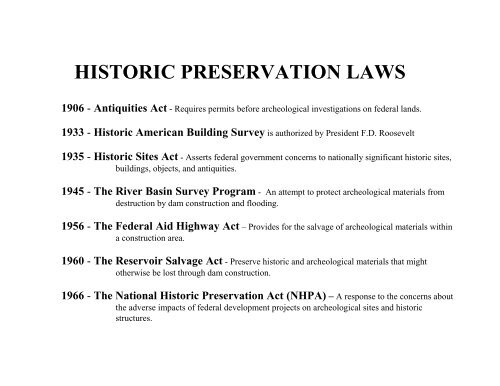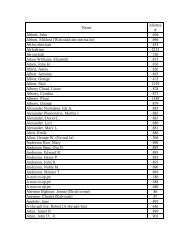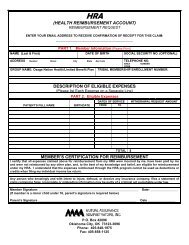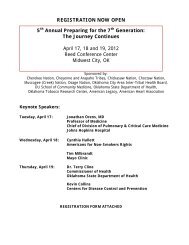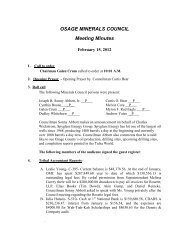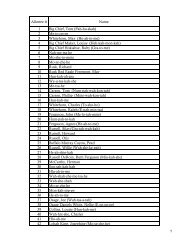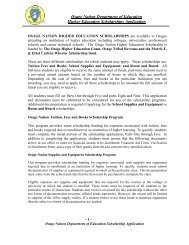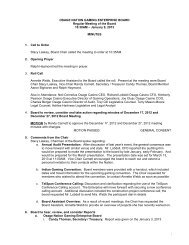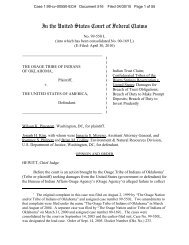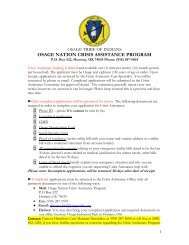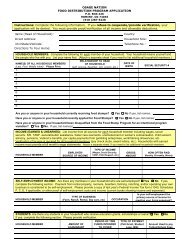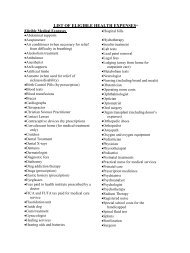HISTORIC PRESERVATION LAWS - Osage Nation
HISTORIC PRESERVATION LAWS - Osage Nation
HISTORIC PRESERVATION LAWS - Osage Nation
Create successful ePaper yourself
Turn your PDF publications into a flip-book with our unique Google optimized e-Paper software.
<strong>HISTORIC</strong> <strong>PRESERVATION</strong> <strong>LAWS</strong><br />
1906 - Antiquities Act - Requires permits before archeological investigations on federal lands.<br />
1933 - Historic American Building Survey is authorized by President F.D. Roosevelt<br />
1935 - Historic Sites Act - Asserts federal government concerns to nationally significant historic sites,<br />
buildings, objects, and antiquities.<br />
1945 - The River Basin Survey Program - An attempt to protect archeological materials from<br />
destruction by dam construction and flooding.<br />
1956 - The Federal Aid Highway Act – Provides for the salvage of archeological materials within<br />
a construction area.<br />
1960 - The Reservoir Salvage Act - Preserve historic and archeological materials that might<br />
otherwise be lost through dam construction.<br />
1966 - The <strong>Nation</strong>al Historic Preservation Act (NHPA) – A response to the concerns about<br />
the adverse impacts of federal development projects on archeological sites and historic<br />
structures.
OTHER FEDERAL <strong>LAWS</strong><br />
Federal agencies have responsibilities under a number of laws<br />
ACHP's regulations encourages coordination of Section 106 responsibilities "with<br />
any reviews required under other authorities such as:<br />
<strong>Nation</strong>al Environmental Policy Act<br />
Native American Graves Protection and Repatriation Act<br />
American Indian Religious Freedom Act<br />
Archeological Resources Protection Act<br />
and agency-specific legislation.<br />
Compliance with one or more of these other statutes does not, by the itself,<br />
substitute for compliance with ACHP's regulations.
NATIONAL <strong>HISTORIC</strong> <strong>PRESERVATION</strong><br />
ACT OF 1966 (As Amended)<br />
Section 106<br />
• Requires federal agencies to afford the Advisory Council on<br />
Historic Preservation an opportunity to comment on the<br />
effect actions proposed by those agencies might have on<br />
properties that are on or eligible for the <strong>Nation</strong>al Register of<br />
Historic Places.<br />
• Applies to federal agencies
Advisory Council On Historic Preservation<br />
• An independent federal agency that is advisory to the<br />
President. The Council has the authority to establish<br />
regulations governing how federal agencies will meet the<br />
requirements of Section 106.<br />
• 36 C.F.R. Part 800<br />
• Regulations for complying with Section 106. These spell<br />
out the process federal agencies must go through in<br />
affording the Advisory Council its opportunity to comment.
NATIONAL REGISTER OF <strong>HISTORIC</strong> PLACES<br />
• Districts, sites, buildings, structures, and objects significant in<br />
American history, architecture, archeology, engineering, and culture<br />
that:<br />
• Are at least 50 years old Retain their integrity<br />
AND<br />
• Are associated with events that have made a significant contribution to the broad<br />
patterns of our history<br />
• Are associated with the lives of persons significant in our past<br />
• Represent distinctive characteristics of a type, period, or method of<br />
construction, are the work of a master, or have high artistic value<br />
• Have yielded, or may be likely to yield, information important in prehistory or<br />
history or<br />
• Are places of traditional cultural importance
SECTION 106 (36CFR 800) PROCESS<br />
• INITIATE PROCESS<br />
• IDENTIFY <strong>HISTORIC</strong> PROPERTIES<br />
• ASSESS ADVERSE EFFECTS<br />
• RESOLVE ADVERSE EFFECTS
Initiate Section 106 Process<br />
• Establish undertaking<br />
• Identify other consulting<br />
parties<br />
Undertaking might affect historic<br />
properties<br />
No undertaking/<br />
no potential to<br />
cause effects<br />
CONSUTATION<br />
COMPLETE
Identify Historic Properties<br />
• Determine scope of efforts<br />
• Identify properties<br />
• Evaluate historic significance<br />
No historic<br />
properties affected<br />
CONSUTATION<br />
COMPLETE<br />
• Historic properties are affected
IDENTIFYING CULTURAL RESOURCES<br />
• CONTACT<br />
– SHPO and/or THPO<br />
– Tribal Government<br />
• POSSIBLE RESPONSES<br />
– No historic properties and no potential<br />
– Complete list of historic properties<br />
– Incomplete list or no record of historic properties, area<br />
has potential
Survey<br />
• Consider <strong>Nation</strong>al Register Criteria<br />
• Identify and consult appropriate expert<br />
– May include tribal elders<br />
• Identify and consult other interested parties<br />
• Secure necessary permits (ARPA, NAGPRA, Tribal)
EVALUATION<br />
• Apply <strong>Nation</strong>al Register criteria in consultation with<br />
SHPO/THPO, Tribe and identified interested parties<br />
(“public”)
Assess Adverse Effects<br />
Apply criteria of<br />
adverse effect<br />
No historic properties<br />
adversely affected<br />
Historic properties are<br />
adversely affected<br />
Seek Concurrence to<br />
complete consultation
CRITERIA OF ADVERSE EFFECT<br />
Alteration, direct or indirect, of any of the characteristics<br />
that qualify a property for the <strong>Nation</strong>al Register, in a way<br />
that would diminish the integrity of its<br />
Location<br />
Design<br />
Setting<br />
Materials<br />
Feeling<br />
Association<br />
Include reasonably foreseeable effects
EXAMPLES OF ADVERSE EFFECT<br />
• Physical destruction or damage<br />
• Alteration<br />
• Removal of a property from its historic location<br />
• Change of the character of the property’s use that affect<br />
features of its historic significance<br />
• Introduction of elements, visual, atmospheric or audible<br />
• Neglect<br />
• Transfer, lease or sale out of federal control without<br />
adequate and legally enforceable conditions
Resolve Adverse Effects<br />
Continue consultation<br />
Memorandum of<br />
Agreement<br />
FAILURE TO AGREE<br />
COUNCIL COMMENT
Section 106 Publications* and Information<br />
ADVISORY COUNCIL ON <strong>HISTORIC</strong> <strong>PRESERVATION</strong><br />
WEB Site: WWW.ACHP.GOV<br />
PHONE for Publications: (202) 606-8512<br />
CONTACT: Paulette Washington<br />
*See handout in training manual


